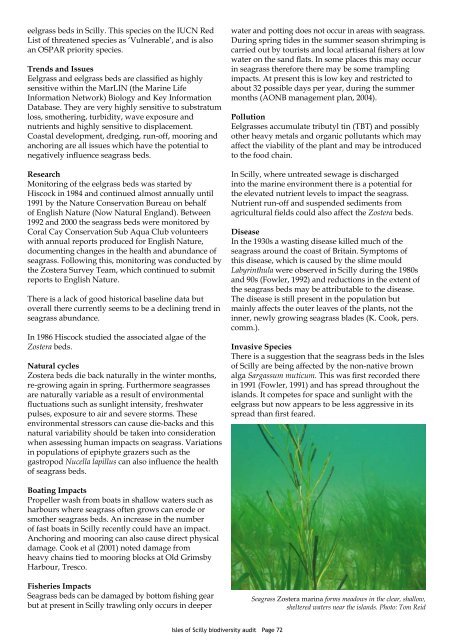The Isles of Scilly Biodiversity Audit 2008 - Cornwall Wildlife Trust
The Isles of Scilly Biodiversity Audit 2008 - Cornwall Wildlife Trust
The Isles of Scilly Biodiversity Audit 2008 - Cornwall Wildlife Trust
You also want an ePaper? Increase the reach of your titles
YUMPU automatically turns print PDFs into web optimized ePapers that Google loves.
eelgrass beds in <strong>Scilly</strong>. This species on the IUCN RedList <strong>of</strong> threatened species as ‘Vulnerable’, and is alsoan OSPAR priority species.Trends and IssuesEelgrass and eelgrass beds are classified as highlysensitive within the MarLIN (the Marine LifeInformation Network) Biology and Key InformationDatabase. <strong>The</strong>y are very highly sensitive to substratumloss, smothering, turbidity, wave exposure andnutrients and highly sensitive to displacement.Coastal development, dredging, run-<strong>of</strong>f, mooring andanchoring are all issues which have the potential tonegatively influence seagrass beds.ResearchMonitoring <strong>of</strong> the eelgrass beds was started byHiscock in 1984 and continued almost annually until1991 by the Nature Conservation Bureau on behalf<strong>of</strong> English Nature (Now Natural England). Between1992 and 2000 the seagrass beds were monitored byCoral Cay Conservation Sub Aqua Club volunteerswith annual reports produced for English Nature,documenting changes in the health and abundance <strong>of</strong>seagrass. Following this, monitoring was conducted bythe Zostera Survey Team, which continued to submitreports to English Nature.<strong>The</strong>re is a lack <strong>of</strong> good historical baseline data butoverall there currently seems to be a declining trend inseagrass abundance.In 1986 Hiscock studied the associated algae <strong>of</strong> theZostera beds.Natural cyclesZostera beds die back naturally in the winter months,re-growing again in spring. Furthermore seagrassesare naturally variable as a result <strong>of</strong> environmentalfluctuations such as sunlight intensity, freshwaterpulses, exposure to air and severe storms. <strong>The</strong>seenvironmental stressors can cause die-backs and thisnatural variability should be taken into considerationwhen assessing human impacts on seagrass. Variationsin populations <strong>of</strong> epiphyte grazers such as thegastropod Nucella lapillus can also influence the health<strong>of</strong> seagrass beds.water and potting does not occur in areas with seagrass.During spring tides in the summer season shrimping iscarried out by tourists and local artisanal fishers at lowwater on the sand flats. In some places this may occurin seagrass therefore there may be some tramplingimpacts. At present this is low key and restricted toabout 32 possible days per year, during the summermonths (AONB management plan, 2004).PollutionEelgrasses accumulate tributyl tin (TBT) and possiblyother heavy metals and organic pollutants which mayaffect the viability <strong>of</strong> the plant and may be introducedto the food chain.In <strong>Scilly</strong>, where untreated sewage is dischargedinto the marine environment there is a potential forthe elevated nutrient levels to impact the seagrass.Nutrient run-<strong>of</strong>f and suspended sediments fromagricultural fields could also affect the Zostera beds.DiseaseIn the 1930s a wasting disease killed much <strong>of</strong> theseagrass around the coast <strong>of</strong> Britain. Symptoms <strong>of</strong>this disease, which is caused by the slime mouldLabyrinthula were observed in <strong>Scilly</strong> during the 1980sand 90s (Fowler, 1992) and reductions in the extent <strong>of</strong>the seagrass beds may be attributable to the disease.<strong>The</strong> disease is still present in the population butmainly affects the outer leaves <strong>of</strong> the plants, not theinner, newly growing seagrass blades (K. Cook, pers.comm.).Invasive Species<strong>The</strong>re is a suggestion that the seagrass beds in the <strong>Isles</strong><strong>of</strong> <strong>Scilly</strong> are being affected by the non-native brownalga Sargassum muticum. This was first recorded therein 1991 (Fowler, 1991) and has spread throughout theislands. It competes for space and sunlight with theeelgrass but now appears to be less aggressive in itsspread than first feared.Boating ImpactsPropeller wash from boats in shallow waters such asharbours where seagrass <strong>of</strong>ten grows can erode orsmother seagrass beds. An increase in the number<strong>of</strong> fast boats in <strong>Scilly</strong> recently could have an impact.Anchoring and mooring can also cause direct physicaldamage. Cook et al (2001) noted damage fromheavy chains tied to mooring blocks at Old GrimsbyHarbour, Tresco.Fisheries ImpactsSeagrass beds can be damaged by bottom fishing gearbut at present in <strong>Scilly</strong> trawling only occurs in deeperSeagrass Zostera marina forms meadows in the clear, shallow,sheltered waters near the islands. Photo: Tom Reid<strong>Isles</strong> <strong>of</strong> <strong>Scilly</strong> biodiversity audit Page 72
















